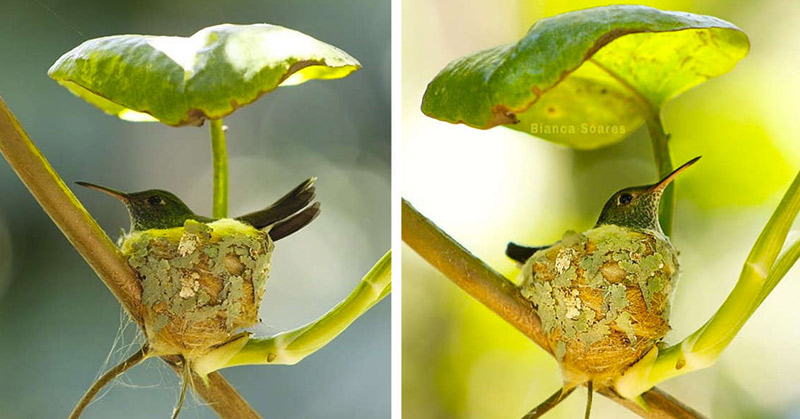Hummingbirds are extremely smart creatures. In fact, they are some of the smartest birds in nature, with brains larger in comparison to their body size than any other birds [1]. Several studies have shown that they will recognize every single flower in their territory and even migration routes.
Then there’s the parental care trait found in birds. After humans, birds are next in line as vertebrates who show a high level of parental care. Some bird species would feed, nurture, and protect their offspring with their own lives.
So, with a combination of pure cleverness and motherly love, this little hummingbird in Paraguay thoughtfully built her nest under the shade of a broadleaf, at least so it would seem. Since hummingbirds (all species) are the smallest birds known to exist, the leaf fit as comfortably as a roof would over her nest.
According to The Dodo, the bird was discovered by conservationist, Bianca Caroline Soares, whose home in Paraguay is dotted by dozens of hummingbird nests [2].

“I saw five hummingbird nests that day, but this was the most ingenious,” Soares told The Dodo. She took several photos of the nest which clearly stood out from the rest. Her crib was the nicest in the neighborhood!
As the weeks wore on, Soares continued to check on the lovely bird and discovered two little chicks in the nest.
“She had two hummingbird babies,” Soares said. Her babies would probably fare better than most others in the area since they were protected from harsh weather conditions.
Read: How To Attract Cardinals, The Ultimate Backyard Tweet-hearts, To Your Yard

Soares is a passionate conservationist who lives in Alto Parana, Paraguay. She hopes that by sharing the hummingbird’s story, people will be inspired to take care of nature and help the planet heal.

Protect the hummingbirds
Hummingbirds are an important part of the ecosystem since they play a major role in pollination. Some species can fly as high as 4,000 meters above sea and ground level where the oxygen supply is very low. They pollinate plants that cannot be reached by other birds. Without hummingbirds, some flowering species in the world may become extinct.
There are 338 species of hummingbirds known in nature. These birds can be found nearly everywhere around the globe, yet they face serious conservation threats [3]. Due to their extremely small size, they are very vulnerable and easily susceptible to dangers such as crushing under human feet, extreme weather conditions, predation by bees, wasps, cats, and other larger animals, habitat loss, and invasive plants.
There are several hummingbird species already listed as endangered, such as the Colombian short-crested coquette and the Ecuadorian black-breasted puffleg.
Read: In Illinois, A Rare Bald Eagle Three-Way Couple Have Come Together To Co-Parent
What can you do to keep them safe?
Provide feeders in shaded areas: Lots of farmers and gardeners use hummingbird feeders to supplement nectar for the birds in their area. It helps prevent the birds from migrating to other locations when there’s a short supply of nectar-producing flowers. These birds are necessary for pollination, so most gardeners try to keep them happy.
Feeders come in the form of hanging dishes or bottles filled with sugar-water solution for the birds to live on when the flowers are not yet in bloom. The feeders should be hung in shaded areas and always kept clean to keep the birds healthy and safe.
Do not spray insecticides near the feeders: Hummingbirds are especially prone to danger from chemicals due to their extremely small body size. While chemical insecticides should be used minimally in your gardens (if at all), they should never be sprayed anywhere near the birds’ nests or feeders.
Prevent bird window-collisions: Hummingbirds are tireless in their quest for sweetness. They can fly at high speed into a window because they do not always see the glass. It’s common to find dead or injured birds lying at the base of your windows. To avoid this, keep feeders far from any windows and break up reflections that might get them confused.
Keep cats away from the nests and feeders: Cats have a natural instinct to chase rats and bids, and since hummingbirds are so small, they are easy prey. Discourage cats from going close to the section of the yard where your hummingbirds are clustered.
Join hummingbird organizations, online and in your vicinity, to support facilities will lead to better hummingbird care and conservation.
- Admin. Hummingbird Behavior. World of Hummingbirds. https://www.worldofhummingbirds.com/behavior.php. Retrieved 11-03-2020
- Stephen Messenger. Clever Little Hummingbird Builds A Home With A Roof. The Dodo. https://www.thedodo.com/in-the-wild/hummingbird-builds-nest-with-roof. Retrieved 11-03-2020
- Endangered Hummingbirds List. The Hummingbird Society. https://www.hummingbirdsociety.org/endangered-hummingbirds-list. Retrieved 11-03-2020
- https://web.facebook.com/bcsoaresz?__tn__=%2Cd*F*F-R&eid=ARBvm3dCUct-VsEjT-kKcKnFMC6Eq2nih1SLj78X_dDJMH7b61fG-JLax1Pf5t7kN60GP6AM1ylZGZkR&tn-str=*F&_rdc=1&_rdr

